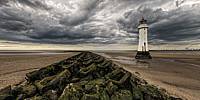© 2015 Rodrigo Alarcón-Cielock, All Rights Reserved.
Perch Rock, New Brighton Lighthouse, sits next to the fort, it was originally, a wooden "Perch", hence its name. A large post held a light on top and was supported by a sort of tripod. It was erected on the Black Rock in 1683 by the Liverpool Corporation.
When foreign ships, passed the old perch, they were charged sixpence for its respect and to keep it in repair. But it was often washed away and a boat had to be launched to recover it from Bootle Bay. In February 1821, the pilot boat "Liver" crashed into the perch and carried it away. It has been said that it was washed away in March 1824 and not recovered until the December.
However the cost of replacing it all the time grew too expensive and it was decided to build a new one.
Construction of the Lighthouse
The foundation stone of the new lighthouse was laid on 8th June 1827 by Thomas Littledale, Mayor of Liverpool. It was designed on the lines of Eddystone by Mr. Foster and built of marble rock from Anglesey by Tomkinson & Company. It rises 90 feet above the rocks and is considered to be a masterpiece of craftsmanship. The granite cost 1/6d a cubic foot.
Each piece of stone is interlocked into the next. The whole stonework, when finished , was coated with what is known as "Puzzellani" a volcanic substance from Mount Etna which, with age, becomes rock hard. The first 45 feet is solid. A spiral staircase leads to where the keeper lived and then on to the lantern house. The revolving light was said to be the first in the country. It cost £27,500 to construct.
The Lighthouse In Use
Work was only possible at low tide and it was not completed until 1830. Its first light shone on the 1st March of that yea and consisted of two white flashes, followed by one red, with a range of 14 miles. The light was 77 feet above the half-tide level. It was eventually electrically connected to the mainland.
The Lighthouse last shone its light on 1st October 1973 as it was no longer needed on account of the radar system operating in the River.
Source: http://www.merseyside.net/newbrighton/pages/lighthouse.htm
- Canon 5D MK III
- Tokina 10-17 FishEye lens @ 10mm / f11
- Nodal Ninja 3 panoramic head
- Manfroto monopod
- Ptgui



 Tap or click the zoom icon in the bottom right corner of the picture to switch between in-page and fullscreen view
Tap or click the zoom icon in the bottom right corner of the picture to switch between in-page and fullscreen view